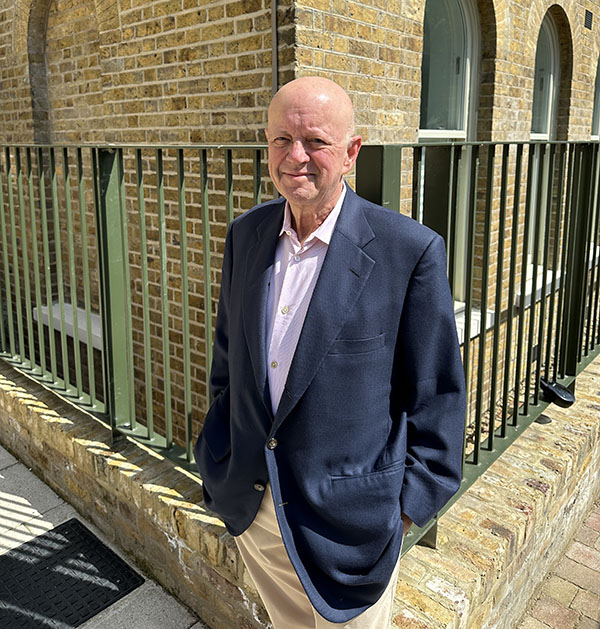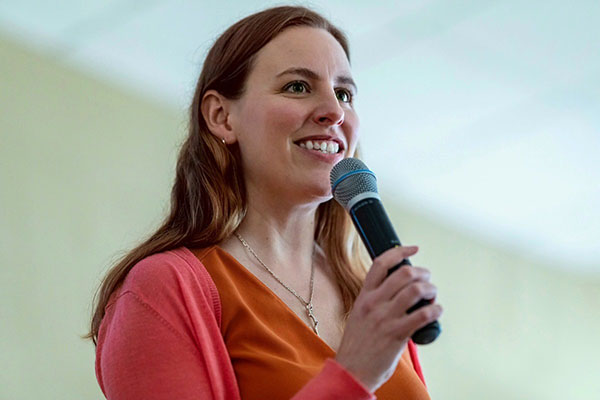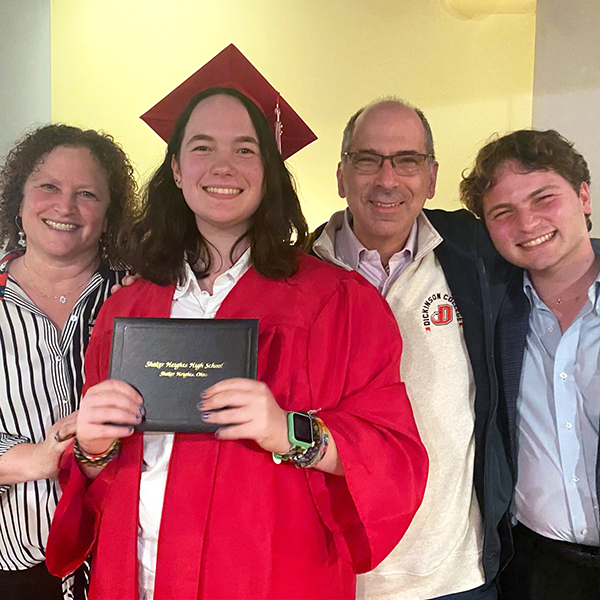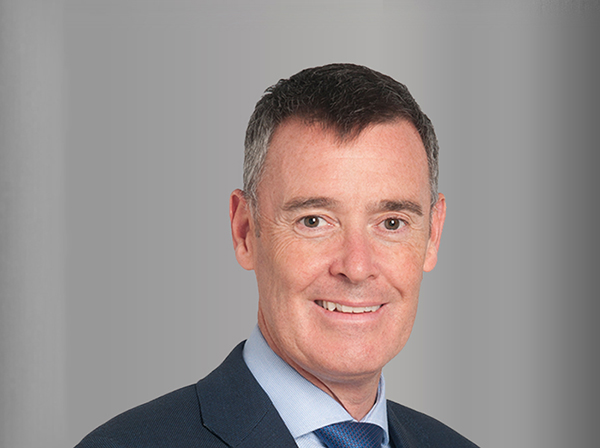Where AI Meets Heart Care

In 1994, Bob Skerker was in China on business when he began to experience chest pain. Though a high-pressure role as chairman and CEO of Robinson Home Products, a family business, prevented him from exercising as often as he would have liked, he was a healthy 44-year-old who never expected to find himself in a Chinese hospital bed during a week of meetings.
After an angiogram revealed a blocked artery, he underwent a percutaneous transluminal coronary angioplasty, or PTCA, a minimally invasive procedure that opens blocked coronary arteries to improve blood flow to the heart muscle. Thirty years ago, stent technology was only just arriving on the scene, so cardiologists relied on PTCA to “squeeze plaque against the arterial wall to clear it out,” Bob explains.
Not long after returning home to Buffalo, Bob headed west to Cleveland Clinic to visit Fred Heupler, MD, the cardiologist who arranged for his father to undergo coronary bypass surgery back in the mid-1970s. “I had no idea that 20 years later, I would become the patient,” Bob says.
At their initial appointment, Dr. Heupler prescribed a regimen of diet, exercise and medication that would help Bob avoid any future health scares. “I remember he told me that I was still very young and could live a long and productive life with the right changes,” Bob remembers. “Something about his calm, professional demeanor inspired confidence. I came to have a lot of faith in his ability and judgment.”
Bob took the summer of 1994 off to rest and reflect on the direction he wanted the next chapter of life to take. He worked long, strenuous hours leading his business to success in manufacturing and developing kitchen products. "The stress was driving my life,” he admits. “I wanted to change that.” When he returned to the office, he maintained a healthy level of exercise but struggled to control his diet and weight. He returned to Cleveland Clinic three times, starting in 1996, to have stents placed. In 2018, he followed in his father’s footsteps with a coronary bypass surgery.
Finding New Purpose
After Bob and his family sold their business to its employees in 2014, he formally retired but didn’t stop working. The same year, a close friend founded the Jacobs Institute, a nonprofit organization dedicated to accelerating the development of life-saving vascular devices. Throughout his career, Bob had poured his time and energy into improving product design and development while managing his business. That skillset served him well as the first president of the Jacobs Institute.
Every morning, the neurosurgeons and cardiovascular surgeons at the Jacobs Institute would meet to review cases and decide which devices to use. Bob would join these meetings to learn more about how surgeons formulated a plan and adjusted it based on how the surgery progressed.
As he was gaining a front-row seat to innovative health procedures, Bob was also developing a friendship with Dr. Heupler, who had recently retired. Though Bob transitioned to a different cardiologist at Cleveland Clinic, he always made a point to have dinner with Dr. Heupler whenever he was in town for an appointment. “Fred and I talked frequently about his career, particularly about technological advances that could help angiographers become more effective,” he says.
Dr. Heupler had developed a passion for using technology to improve cardiac care, and his enthusiasm was contagious. Bob had long served on philanthropic boards and devoted his time to worthy causes, mostly in culture and the arts, and he began considering ways to expand his impact.
This year, he made an estate gift to support cardiovascular research utilizing artificial intelligence, machine learning, and similar applications at Cleveland Clinic Sydell & Arnold Miller Family Heart and Vascular Institute.
“This gift is in honor of Fred,” Bob shares. “It is because of what he has done for me and my family, as well as thousands of other patients, that I am motivated to give back.”
Declining Zero
When he considers the impact of AI in cardiology, Bob draws a comparison to his time in manufacturing. He remembers discussing cereal quality with a large food manufacturer and learning about the concept of “declining zero.” The client shared with him that with new technology, they can detect impurities in cereal that would have been previously undetectable. For this reason, a box of cereal manufactured 10 years ago would fail quality checks today.
“I suspect the same is true in cardiology,” Bob reflects. “Thanks to advances in AI, what was undiscoverable is now discoverable, and that changes everything.”
According to a recent survey conducted by Cleveland Clinic, three in five Americans believe AI will improve cardiac care. From using a wearable device to track and identify patterns in heart rate to using AI-enhanced imaging during cardiac procedures, AI applications in cardiology are vast and growing.
Bob and Dr. Heupler have also talked at length about the mountain of data derived from patient blood tests and functional tests. Typically, a doctor must browse through an extensive collection of testing data and discern their meaning. For a patient like Bob, whose chart contains 30 years of data, this task is formidable. “A human only has so much capacity to absorb all that information,” Bob says. “But AI algorithms can process and interpret data in a fraction of the time, finding meaning that is hidden to the human eye.” With AI serving as a clinical partner, doctors are better equipped to make faster, more accurate diagnoses and optimize patient outcomes.
When Bob underwent his first heart procedure back in 1994, his doctor didn’t use stents. Three decades later, technology has grown in leaps and bounds. By making an estate gift, Bob aims to make an impact that outlives him by supporting technology that will only become more relevant with every passing year.
“AI is not something that’s static,” he says. “It will constantly be tweaked and improved with the goal of accelerating innovation. In the right hands, this technology will improve the lives of countless patients like me.”
Investigating the Imbalance of Alzheimer’s Risk

Since 2016, the Alzheimer's Association and Women’s Alzheimer’s Movement at Cleveland Clinic (WAM) have partnered on funding initiatives that support women in science and grants focused on exploring sex differences in Alzheimer’s. When the COVID-19 pandemic struck, the Alzheimer's Association and WAM provided grant funding to several researchers to ensure their critical investigations were able to progress during this challenging time. This article is the second of three in a series exploring the impact of their work. Read the first article here.
We know dementia affects everyone, but the burden is not necessarily distributed equally. There are gender differences and minority populations at disproportionately higher risk for dementia, according to Megan Zuelsdorff, PhD. This imbalance interested her from an early age.
The assistant professor at the University of Wisconsin-Madison School of Nursing and lead investigator at the Wisconsin Alzheimer’s Disease Research Center at UW School of Medicine and Public Health became fascinated with epidemiology and people’s “social connectedness” while working with health psychologists as an undergraduate student. She decided to study the influence of people’s social environments on their cognitive health and their risk for dementia – “and also their ability to prevent age-related cognitive impairment and stay cognitively healthy and live independently with a good quality of life for as long as possible.”
The team’s biggest project currently is the Stress and Resilience in Dementia Study, or STRIDE.
“The Alzheimer’s Association funded this opportunity for me to reach out specifically to our African American and our rural participants and say, ‘We know that social environments are important, that social histories are important. But we really want to find out from you what your lived experiences are, what these variables, these exposures, look like for you,’” Dr. Zuelsdorff said. “I wanted to look at risk factors in social environments, but also resilience and protective factors and focus on what I felt were gaps in the research.” These populations, she explained, are at elevated risk of dementia but hadn’t been included in past research studies.
Dr. Zuelsdorff was most interested in looking at stress and adversity in these populations. “We can’t always control the things that happen to us. … You lose people, you develop chronic illnesses, you develop functional limitations that really change your life.” Retirement can be a significant stressor, too, she noted.
“But we also wanted to look at individual and community assets that are beneficial for cognitive health, maybe actually buffering the impacts of stressful life events, whether through emotional coping resources or embedded in social networks or material resources available to us. If you’ve got a social network that’s well resourced, you’re better able to rely on those folks to get you through.”
Research has shown that social relationships are beneficial in other ways, according to Dr. Zuelsdorff. When you’re living with or spending time with other people, you’re more likely to eat healthy and go to a doctor when you’re sick. She also hypothesizes that conversations with other people can provide the same mental benefits as sudoku or a crossword puzzle and that social connectedness is associated with better cognition. “(Conversations) build a brain that is healthier and can be more resilient, even if there’s amyloid and tau pathology (the defining features of Alzheimer’s disease) brewing … creating vulnerability.”
People’s understanding of amyloid levels and Alzheimer’s risks are important to Dr. Zuelsdorff. “One of the (preliminary) findings I’m most excited about is in an era where people are going through (screening) tests to determine their Alzheimer’s pathology levels and we’re disclosing that information to them … it’s really important. We’re also providing them with recommendations and hope in the form of research findings.”
At the start of 2020, with the outbreak of COVID-19, Dr. Zuelsdorff and her team experienced staffing challenges and knew they had to address how the pandemic might affect cognitive health and dementia risk.
“There was a lot of news about people who had relatives in assisted living and nursing homes who they couldn’t visit, and they felt they were declining really fast. Social isolation came to the forefront. All these connections that we had taken for granted were suddenly disrupted. And the impacts were huge and immediate. In the short term, this was more important than the research gaps.”
Extra funding from the Women’s Alzheimer’s Movement (WAM) – a nonprofit organization for women and Alzheimer’s founded by Maria Shriver and in partnership with Cleveland Clinic – allowed Dr. Zuelsdorff’s team to adjust their study’s protocol and extend its duration. “We had been seeing people in person and sending them home with study kits. We shifted everything to telephone but we were able to be more connected because we could stay in contact longer and we could call participants any time of day and stay on the phone for as long as they wanted to talk. It was just incredible having funding and this support at a time when everything was topsy-turvy.
“We’ve known people with higher levels of social support have better cognitive health,” acknowledged Dr. Zuelsdorff. “The new news is that it looks like social support may be particularly important and protective for people who have a vulnerability to dementia.” Among people who have preclinical signs of dementia, social support is particularly important for better cognitive function.
“I think we have an ethical responsibility as Alzheimer’s and dementia scientists to understand modifiable risk factors and protective factors so that we can provide information and make recommendations to people regardless of where they’re at in terms of their progression, in terms of their biological risk and so on. There are modifiable parts of this disease and the disease trajectory.” She notes there also are policy changes that can address social inequalities in dementia risk, care and research.
“I’m excited about the potential for pharmacological treatments for people who have Alzheimer’s disease,” she said, with the caveat: “I hope that we will always pair those with a lot of supportive interventions that help people live their best lives. Regardless of your risk, social connections are going to keep you healthier longer. I want to give people hope as they age, as they watch family members struggle with dementia, as they worry for themselves. I also think it’s really important to recognize that there is a lot of life to lead after a diagnosis of dementia.”
Gratefully Celebrating Two Milestones

Rob Nosanchuk watched proudly as his youngest child, Hope, was awarded a diploma for graduating from Shaker Heights High School in June 2024. It was a milestone event the 54-year-old rabbi thought he might never have an opportunity to see, after being diagnosed with stage 4 metastatic melanoma in 2019. He recently experienced a celebratory milestone himself. After 24 months of immunotherapy, followed by our oncologists consistently monitoring him for three years, Rob reached complete remission in May 2024 – meaning that for five years, he has not had new evidence of disease in the years ensuing his treatment.
However, he continues to face lingering side effects from checkpoint inhibitors, a form of immunotherapy. While some patients who receive immunotherapy have no side effects or very few, Rob has experienced inflammation in his joints, colon and thyroid, permanent adrenal insufficiency, and neurological and cognitive impairments. “That doesn’t change the fact my number one emotion is gratitude. I was in the hands of the best oncologists and specialists, and they made sure I have gotten the most effective treatment possible at every stage,” says Rob.
Rob’s medical oncologist, Lucy Boyce Kennedy, MD, and an army of experts have worked together to effectively treat his cancer and immune-related adverse effects (irAEs). “While some patients may get irAEs, and some of those side effects may be permanent, immune therapies have tremendously improved survival in patients with metastatic melanoma. There is even potential for some individuals — like Rob — to be long-term survivors,” says Dr. Kennedy.
Rob had a form of skin cancer known as metastatic melanoma with unknown primary, which means there was no obvious site on the skin where it originated. His main symptom was severe abdominal pain.
In 2021, Rob and his wife, Joanie, established the Nosanchuk-Berger Skin Cancer and Melanoma Research Fund at Cleveland Clinic to support melanoma and irAE research and improve the patient experience. While Rob’s irAE-related treatments will continue indefinitely, Rob avows those struggles don’t compare to the seemingly dire prognosis he potentially faced when diagnosed more than five years ago. “If cancer does come back, or any other health event, I want to be physically and mentally healthier and stronger for it. And I am on that path,” states Rob.
Cleveland Clinic Florida Quarterly Update

Dear Colleagues and Partners,
As we enter the summer season, I am reminded of the many ways in which we can make a positive impact on the communities we serve.
Your unwavering support and dedication are the backbone of our success. Thanks to your generosity, we have made significant strides in physician recruitment as well as attained milestones through published research from the Florida Research and Innovation Center (FRIC) that we look forward to sharing. These accomplishments are a testament to the power of our community and the difference we can make when we come together.
In the first half of 2024, we added 21 new physicians throughout the region, and we anticipate welcoming an additional 63 physicians by the end of the year. This will bring our grand total of new hires in 2024 to 84, contributing to our mission of providing exceptional healthcare.
This significant achievement is a testament to our commitment to expanding our team with highly skilled and compassionate professionals who are dedicated to delivering world-class care to our patients. It also underscores the attractiveness of our organization as a premier destination for medical professionals who seek to make a meaningful impact in the communities we serve.
From improving access to care to contributing to major discoveries at FRIC linking viruses to certain types of cancer, Cleveland Clinic brings compassionate care and leading-edge research to you and your neighbors, as well as people around the world.
We are sincerely grateful for the support of our community partners, stakeholders and philanthropic supporters, whose generosity and dedication are a vital part of our continued growth. These contributions help us expand our team and enhance our ability to provide innovative medical care and improve patient outcomes across our region.
Thank you for your unwavering commitment to Cleveland Clinic Florida.
Warmest regards,
Conor P. Delaney, MD, PhD
President of Florida Market
Executive Vice President, Cleveland Clinic

